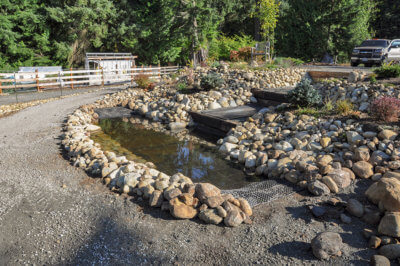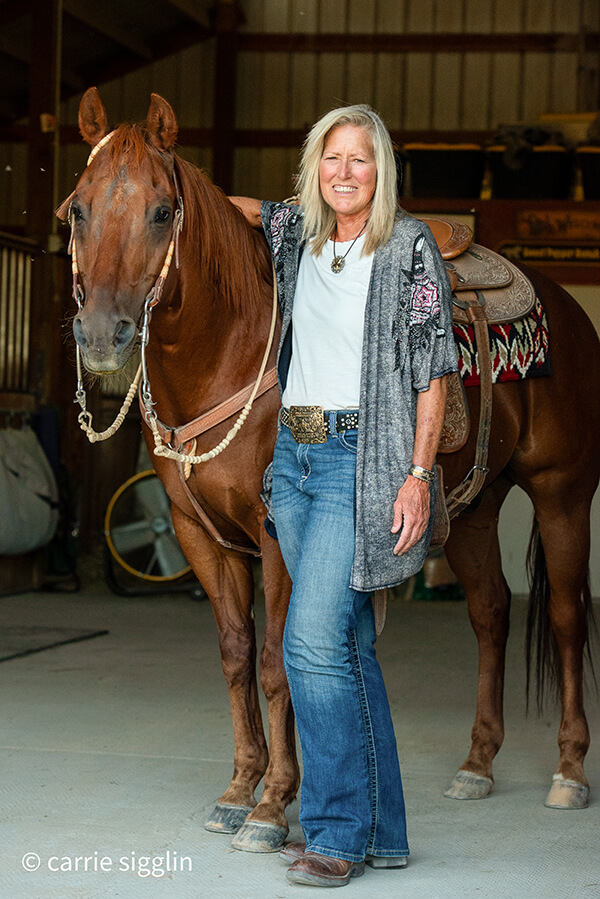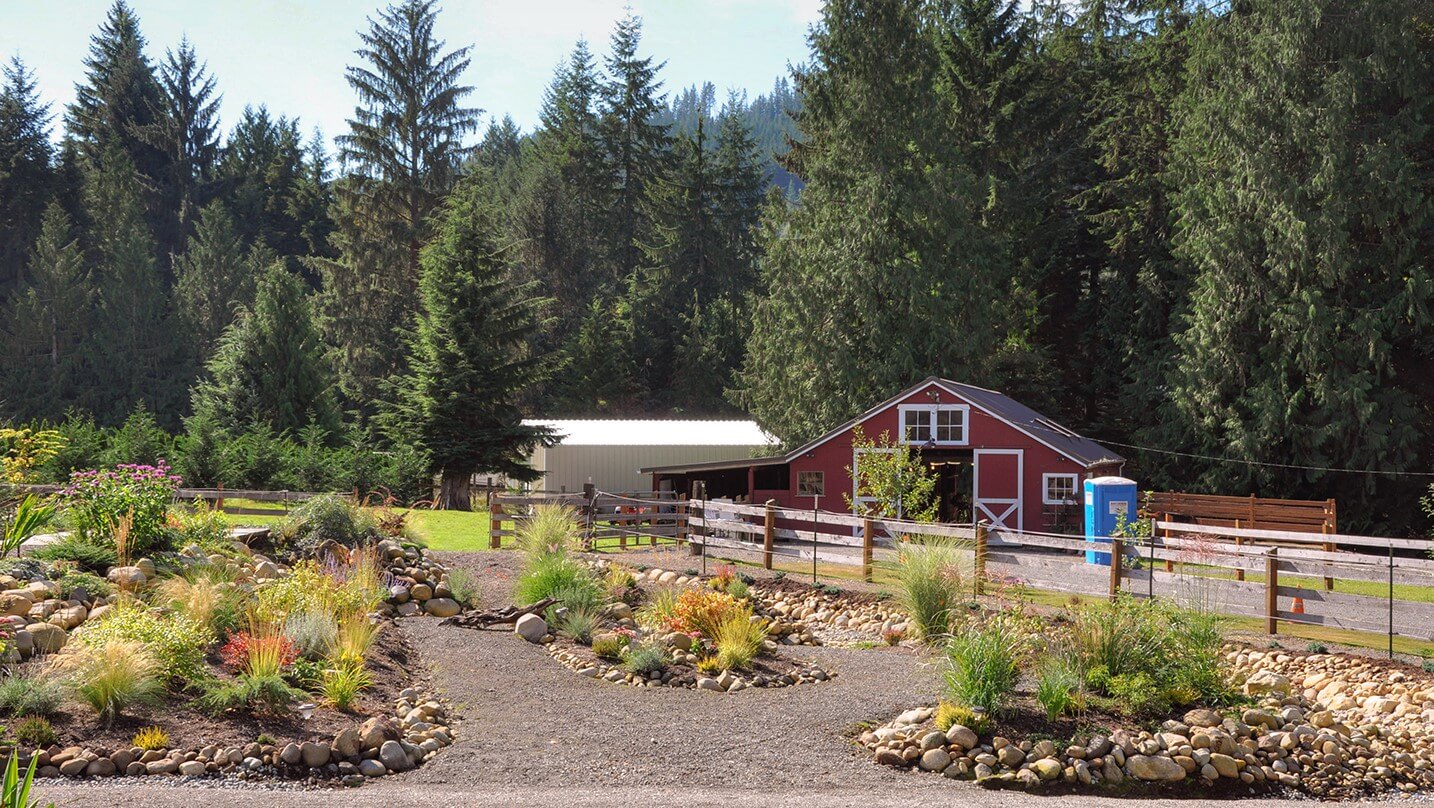Trail courses are fun for horses and riders and can be beneficial for the natural environment. Landscaping a trail course with native plants can provide food and habitat for native insects and wildlife. Add in old logs and brush and rock piles, and you have the perfect habitat for other small critters too. Native plants (and plants in general) can help with mud management by drinking up excess water and helping to dry out an area.
Here are 10 reasons to build a small-scale trail course on your property:
- Exercise and training for your horse. All performance horses need a break in their training routine. Any age horse from any discipline can gain positive experiences from navigating trail obstacles under saddle or in-hand.
- Change of pace for you and your horse. Maybe one or both of you needs a break from the usual routine. Trail work might also be a good way to start bringing a horse back from an injury, hand walking them through easy trail obstacles.
- For when you can’t get out on the trail. A few obstacles can give you a chance to practice “real life” trail skills such as stepping up a big step, side passing, stepping over logs or through brush, or walking through a narrow space.
- Enrichment for your horse. Equine enrichment provides stimulation in a horse’s environment to benefit their psychological and physical well-being. Trail obstacles make them think outside the arena box, challenging and stimulating them. Backing through a chute, different footings, walking through water—all of these are much different than everyday arena work.
- Property aesthetics. Trail obstacles can be an attractive landscaping feature for your property. Adding in a bench for spectators lends additional eye appeal. Maybe include a pollinator hedgerow for a splash of living color. Add in objects for interest, such as an old wagon wheel or piece of farm equipment. These kinds of objects can be placed off the beaten path for safety.
-

Storm water trap for water obstacle. Photo by Alayne Blickle Utilize a small space on a horse property. A few objects next to the driveway, behind the compost pile, or in an unused corner of the pasture might be all it takes to create a trail course. Almost any sized property can accommodate at least a few obstacles.
- Can be low-cost. Using native plants and natural features like rocks and logs or other found objects can be an easy, inexpensive way to accomplish this.
- Mud management and storm water control. For mud control and help with heavy rainfall during storm events, consider weaving pockets of native shrubs into your trail course or maybe even a rain garden or two. A rain garden is simply a shallow depression in the ground, planted with native plants, that captures and temporarily holds rainwater from downspouts or from surface water. Choose plants that don’t mind getting their feet wet. Not only will this add visual appeal, but it will trap and slow rainwater, allowing it to infiltrate the ground and reduce mud.
- Provide habitat for native animals and beneficial insects with native plants, brush piles, old logs, rock piles, etc. Native plants are those that have evolved over thousands of years in your specific regions. These hardy plants have adapted to local geography, hydrology, and climate and have co-evolved with animals, insects, fungi, and microbes. This is important since it means we don’t have to spend money and time helping them along with pesticides or fertilizers, further reducing environmental impact. Native plants are the foundation of our natural ecosystems, so a community of native plants provides habitat for a variety of native wildlife species such as songbirds, pollinating insects, and butterflies. Your trail course can be home to some of these wonderful creatures. NOTE: Many species of plants are poisonous to horses such as black walnut, yew, red maple, black locust, rhododendron, laurel, oak, and most fruit trees. ASPCA has a list of plants toxic and non-toxic to horses or consult your equine veterinarian if unsure.
- Great way to recycle objects. Instead of burning or taking those old wooden fence posts to the landfill, incorporate them into your trail course. You can do the same with other objects like fallen logs, downed branches from the last windstorm, or old tree stumps. Thin trees or posts can be used for side passing, larger logs to step or jump over. I often scan neighbors’ or friends’ properties for discarded items that could become something useful at my place. This has netted items such as an old stock tank I turned into a planter, a bent metal gate we straightened and hung as a practice gate (to open from horseback), and a discarded mailbox that works great as a trail obstacle to practice side passing up to and opening. Look online to find other free things like electrical spools or wooden pallets, both of which can be made into interesting obstacles. We got a pile of old railroad ties this way and are using them to build new obstacles like back-through chutes. The sky’s the limit on items that can be reused and made into fun obstacles.
Be creative but be sure to keep things safe. Avoid protrusions, rough edges, sharp corners, or pockets that a foot or leg can get cut on, trapped under, or stuck in. Then have fun and ride on—and know you are also doing a bit of good for the natural world as well.
Visit the Sweet Pepper Ranch website for info on our upcoming spectacular 3½ day Sweet Pepper Ranch Cowgirl Retreat, August 26–29, 2021. Includes ranch riding, yoga, meditation, lectures, demos, gourmet meals, field trips, relaxing pool time – and more!
See this article in the July 2021 online edition:

Alayne Blickle began in the 1990’s as a pioneer in water conservation and natural resources conservation by creating the entrepreneurial consulting business, Horses for Clean Water, an award-winning internationally acclaimed education program that looks for horse-healthy, nature-based solutions to land management challenges. She continues this work today partnering with agencies, organizations, and horse owners throughout North America and worldwide. She is a regularly contributing writer and photojournalist to several equine publications.
Alayne lives with her horse trainer husband, Matt Livengood, in southwestern Idaho where they raise and train AQHA horses and mustangs on their eco-friendly horse ranch. Contact her through the Horses for Clean Water website or through their ranch website Sweet Pepper Ranch.
For more information contact Alayne at [email protected] or 206-909-0225.






